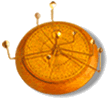Slovenian Language: The Introduction
Slovenian
is the national language of the Republic of Slovenia and Slovenian
minorities in Austria, Italy and Hungary. It is also spoken by Slovenian
immigrant groups in USA, Canada, South America and Australia. Slovenian
speaking territory between Austria in the north, Hungary and Croatia
to the east and south, and Italy to the west reaches further west
than any other Slavic group, in the past as far as the hinterland
of Venice.
Slovenia
has a population of 2 million. There are a further half a million
speakers of Slovenian outside its borders and around the world.
One
of the Slavic family of languages, Slovenian is most closely related
to Croatian and Serbian. It is usually grouped together with the
South Slavic languages. It is however distinguished from them, in
that it has retained archaic proto-Slavic features and lexical characteristics,
which indicate a greater age and a strong lexical relationship with
the north Slavic type (Bezlaj). For instance, the linguistically
rare dual number still in use today
links Slovenian to the Lusatian Slavic, the
supine to Czech, the genitive case
in the negative form to Balto-Slavic group. Unlike Serbian
and Croatian, Slovenian is characterized by a great number of dialects
- about 50 dialects and subdialects - which indicates its greater
age.
The
language presented in grammars and taught in schools and universities
is known as Contemporary Standard Slovenian.
It is the language of educated Slovenes and is used in all forms
of artistic endeavour and in the media. More than anything else,
Slovenian language has kept the Slovenian nation alive and united
as a culture over centuries of suppression. Despite many attempts
to destroy it, it is alive and dynamic today.
Slovenian is grammatically complex with six cases for nouns, adjectives
and pronouns, three genders and four verb tenses. In addition to
singular and plural, Slovenian has something rare in linguistics
the dual number: not only reka (river) and reke (rivers), but also
dve reki (two rivers). The matters become very complex when one
considers special endings for gender, numbers and different classes
of nouns.
The
script is Roman and there are only 25 letters, the specialty being
s, c z with a caron a small "v" on top of each (in Slovenian
"little roof") on top, which indicates sh, ch, and zh
sounds.
Like
English, there are different values for vowels. For instance, vowels
"o" and "e" may be stressed or unstressed, long
or short, open or closed, with further subtle variations in the
pronunciation. One learns by listening closely and repeating words.
The exact values are not indicated, apart from course-books and
dictionaries and that is often only an approximation.
Slovenian
has free stress, i.e. it may fall on any syllable of a word. Furthermore,
once established, the place of stress may be non-mobile, i.e. remain
on the same syllable throughout any inflections and changes, or
it may be mobile. However, this happens less frequently.
Aleksandra
Ceferin, Thezaurus (Melbourne 2000)
|

